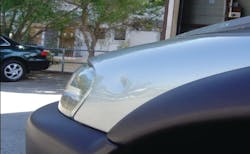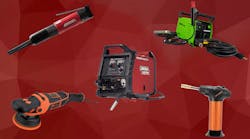Tommy Clayton is the owner of Tommy’s Dent Services in Gibsonville, NC. He is also the president of the National Alliance of Paintless Dent Repair Technicians (NAPDRT). Here he describes some background about the industry and of his own involvement, and information that can help you understand the business opportunities available to your shop.
Paintless Dent Repair (PDR) is a relatively new industry currently experiencing growth in the United States. Dating back only to the 1950s, PDR began in European factories and now consists of three main segments: hail, wholesale and retail.
My PDR career began in 1992 with intensive training for three months. It was another year and a half before I was comfortable enough for retail repairs, but today I work in all segments of PDR (hail, wholesale and retail). In 2006, I helped found the NAPDRT (National Alliance of Paintless Dent Repair Technicians). I am also Vale Master Craftsman Certified and received the 2008 PDR Mentor of the Year Award at the International Mobile Tech Expo.
PDR technicians who specialize in hail usually follow (or chase) storms around the U.S. and across the world. They repair vehicles for consumers, dealerships, manufacturers and body shops. Their jobs are typically arranged by the technician or a broker. Wholesale repairs are made for used car dealers. Retail repairs are made directly for the consumer at body shops and at service/repair shops.
Many service shops have dramatically increased their revenue by adding a PDR program to their service offerings. Aside from increasing a shop’s profits, there are several other advantages to expanding your shop to include PDR. A new service, such as PDR, can also be invaluable in attracting, growing and retaining customers for your business.
Getting Started
Before a shop begins the process of adding PDR services to their offerings, it’s important to research the current PDR environment in your specific area just as you would any other service business decision. For instance, shop owners will want to find out how many PDR technicians are already in the area.
Many technicians don't advertise, so calling dealerships and body shops and asking for references is the most likely way to determine the number technicians in the area. Try to determine who has the best quality coupled with a business plan that will mesh with your particular shop.
NAPDRT also has a tech locator on the website (www.napdrt.org) to help match technicians to consumers and other businesses. This is another good resource for shops considering adding PDR and looking for qualified technicians in the area.
There are two main paths for adding PDR to a shop: subletting to an outside technician or training an in-house technician. There are pros and cons to both, but I definitely recommend nearly all shops look at subletting instead of training an in-house technician. Subletting a shop’s PDR business to a qualified technician instantly creates a profit center. It takes time and an investment on the shop owner’s part for in-house technicians to learn PDR and the attrition rate of those newly trained technicians is high. Although some sources advertise one- or two-week schools or video training for PDR, it takes years to become proficient even after an intensive a month-long, one-on-one training process.
A qualified technician brought in to handle PDR business for a shop can be integrated easily into a shop’s operations. That tech would need to provide only basic training to the other shop personnel on issues such as estimating, repair times, the repair process and limitations of PDR as a whole.
Maintaining efficiency
Shops that add PDR services do need to be mindful of potential scheduling conflicts, and they should have the resources to plan accordingly to maintain their efficiency levels. The PDR technician and shop personnel need to establish a communication policy for scheduling options, and create a back-up plan for emergencies and miscommunications as a safeguard.
A final word of advice to shops considering adding PDR as a profit center: get involved in the industry. NAPDRT was created to unite PDR technicians and provide reliable information about the PDR services. The organization has also created standards and is educating the public about top-quality paintless dent repair. Shop owners who have already incorporated PDR into their business are another great resource and can provide valuable insight gained from firsthand experiences.
Automotive Service & Repair Week (ASRW), held this year at the Orange County Convention Center in Orlando, FL, Oct. 6-8, is an excellent opportunity to meet and network with shop owners across the country, find PDR vendors and get answers about mechanical and collision shop questions. NAPDRT exhibits there too, and I invite you to stop by our booth. I’ll be glad to answer any of your PDR questions.
About NAPDRT
The NAPDRT is a non-profit organization created to allow individual PDR technicians to unite and address the problems and issues affecting the entire PDR Industry. We believe the best way to solve these problems is to provide strength through numbers. Critical issues are currently being decided by a small handful of companies claiming to speak for and represent the entire PDR Industry. Without the NAPDRT, thousands of independent PDR Technicians are left without a voice or input into these critical decisions that are affecting the PDR technician’s livelihood and future.


